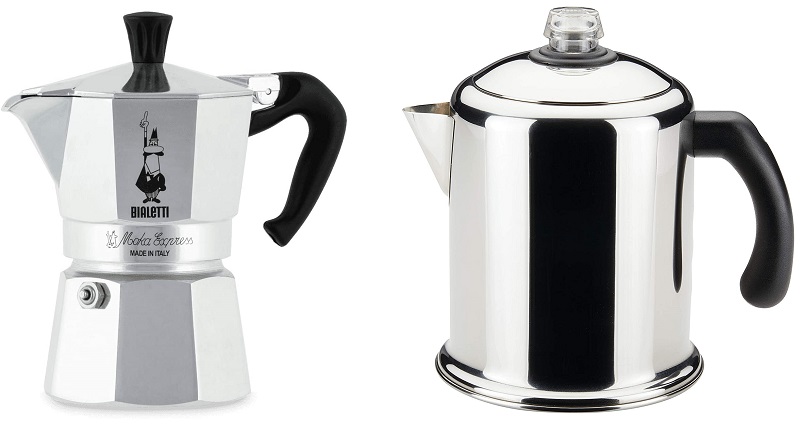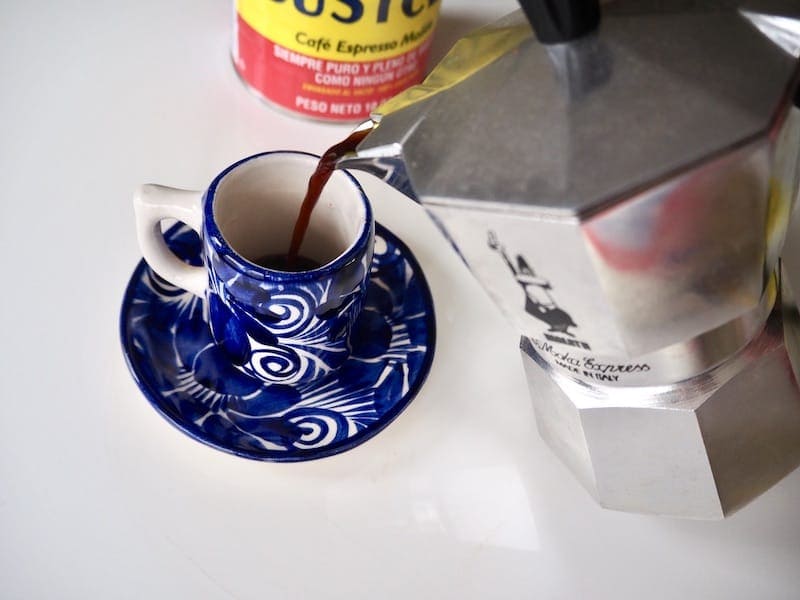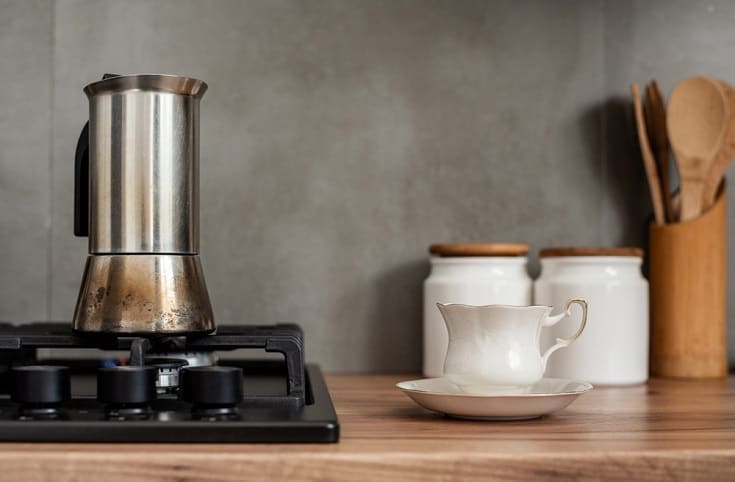
To the untrained eye, it might seem like a Moka pot and percolator are six of one, half a dozen of another. After all, they both make coffee, right? Well, yes, but that’s pretty much where the similarities end. Moka pots make small batches of strong, concentrated coffee and are often called stovetop espresso makers, even though that isn’t quite right. Percolators, on the other hand, make large pots of average-strength coffee. Percolators are workhouse machines that used to be the go-to coffeemaker for restaurants and diners before modern drip coffee machines became prevalent.
In this article, we’re going to compare and contrast Moka pots with percolators. The two are very different despite their outward similarities, so we will go line-by-line, sparing no expense to bring you all the details you need to know to choose which one is right for you. Spoiler alert: most people could probably use one of each. Let’s get started!

Overview of Moka Pots:
How Does a Moka Pot Work?
Moka pots are one of the oldest methods for making coffee. They’re technically percolators, which means that they pass water through coffee rather than let coffee grounds soak in water, like a French press. What sets Moka pots apart from other percolation brewing methods is pressure.
To make coffee with a Moka pot, you pack finely ground coffee into a small chamber at the base of the Moka pot and fill the bottom with water. Then you place the Moka pot over a heat source—typically a burner on your stove—and wait.

As the water heats up, pressure builds up as the water begins to boil and turn to steam. When the pressure is high enough, the water starts to look for a way out and gets forced through the coffee up into the main chamber of the Moka pot. Once all the water has boiled away or been forced through the coffee grounds, your coffee is ready.
What Does Moka Pot Coffee Taste Like?
You might be tempted to make a comparison between Moka pot coffee and espresso. Both methods utilize pressure to brew coffee, so the similarity is striking. The major difference between espresso and Moka pot coffee is that the Moka pot’s pressure is much lower. For coffee to be technically considered espresso, the pressure must reach a whopping nine bars, which is unattainable in a Moka pot.
Even though Moka pot coffee isn’t technically espresso, it is somewhat similar. Moka pot coffee is strong and concentrated and served in small doses. Unlike espresso, Moka pot coffee doesn’t have that smooth layer of microbubbles called crema on top. Espresso fans love crema, and it is one of the main reasons espresso is so popular and the main reason that Moka pot coffee is less well-known.
However, since both espresso and Moka pot coffee are strong and consumed in small amounts, some refer to Moka pot humorously as “faux-spresso.”
Should You Try a Moka Pot?
If you like strong coffee, you’ll probably love brewing with a Moka pot. It’s fast, easy, and one of the best ways to make bold, flavorful coffee.
Moka pots are also relatively cheap, making them an attractive option for people who want to make an espresso-like coffee at home without refinancing their house first.
The major downside of making coffee in a Moka pot is the batch size. Moka pots are tiny and can only make a few ounces of coffee at one time.

The dosing is very similar to espresso, so think single and double shots rather than one or two mugs. If you make large batches of coffee for yourself or guests, a Moka pot will have a tough time keeping up with demand.
- Makes strong, robust coffee
- Easy to use
- Inexpensive
- Easy to clean
- Only makes small batches
- Coffee is very strong—too strong for some people

Overview of Percolators:
How Does a Percolator Work?
Percolators are similar to Moka pots in many ways. They look sort of like giant Moka pots and even function in a similar way, but the coffee they make is completely different.
On the surface, percolators seem like they work in exactly the same way that Moka pots do. All that you need to use a percolator is coffee, water, and a source of heat. So far, that sounds pretty similar. However, unlike a Moka pot, percolators use a medium to medium-coarse ground coffee rather than a fine ground coffee. Even though that sounds like a small difference, it actually changes the coffee’s flavor a lot.

Another difference is where the coffee sits. In a percolator, the coffee is held in a basket near the top of the percolator by the lid. The water fills the percolator and then is heated, either on a stove or by electric coils in the base. As the water heats, it is forced up through a pipe-like structure attached to the basket where the coffee sits.
The heated travels up the pipe and spills out of the spout into the coffee basket where it slowly drains through the grounds—or percolates—and voila, you have coffee. A major difference between percolators and Moka pots is that percolators don’t use high pressure to force water through fine coffee grounds. Water takes a leisurely path through the grounds and drains through only because of gravity.
How Does it Taste?
Percolator coffee is regular strength coffee, so it tastes like your average cup of Joe. Some people don’t like how percolator coffee tastes because it is prone to over-extraction and bitterness. The process of bubbling through a pipe and haphazardly spilling onto the coffee grounds is unsurprisingly imprecise. You don’t have any control over where the water goes leading to channeling and over-extraction.
Is a Percolator Right for You?
You might be thinking after our last remarks that no one likes percolator coffee, but that’s not the case. Percolators are unparalleled in their ability to make large batches of coffee quickly and consistently. While it does tend to be more bitter than other methods, percolator coffee is far from undrinkable.
If you regularly need to brew large batches of coffee, you should consider picking up a percolator. You won’t make top-notch specialty coffee with one, but for after-dinner coffee drinks, they’re perfect.
A less important consideration is aesthetics. Percolators have a distinct vintage look and feel to them that makes them great conversation pieces if you keep them on your kitchen counter. How a brewer looks has nothing to do with making quality coffee, but it is an important factor for some people.

Another point in favor of percolators is the price. They tend to be cheap since they’re seen as old, obsolete technology by many people. We disagree and think that their capacity and convenience still have a place in a modern coffee arsenal.
- Easily makes large batches
- Cheap
- Very easy to use
- Vintage aesthetic is appealing to some
- Prone to bitterness
- No control over the brew

Moka Pot vs Percolator: Factors to Consider
Price
Both percolators and Moka pots are relatively cheap compared to similar coffee products with similar functionality. However, in an absolute sense, Moka pots are cheaper. You can pick up a three-cup Moka pot for about half the price of a standard percolator. The main difference is the percolator will probably be able to make more than twice as much coffee.
If you’re looking to spend as little as possible, go with the Moka pot.
Convenience
Moka pots and percolators are similarly easy to use and significantly simpler than many alternate brewing methods. Percolators are slightly easier to use since they don’t require special fine ground coffee to work properly. Both Moka pots and percolators are easy to clean and don’t have any moving parts. It’s slightly annoying to fill a Moka pot sometimes due to the small size of the coffee basket, but it’s mostly a non-issue.

This one is a wash; both are easy to use and clean, and you won’t notice a major difference using either one.
Flavor
Here’s where we get to the main event. Moka pots, quite frankly, blow percolators out of the water in terms of taste. Moka pot coffee is strong and bold, without being bitter, while percolators brew different coffee every time. Sometimes you’ll wind up with a standard—but unremarkable—regular old cup of coffee but other times, you’ll get a harsh, bitter mess. Using a percolator can be frustrating because what you do has only a small effect on the outcome you get.
If you want to make robust, concentrated, delicious coffee, get a Moka pot. This category isn’t even close.

Final Thoughts
We hope you enjoyed this head-to-head showdown between Moka pots and percolators. Both styles of coffee makers have their place and which is right for you depends on your personal taste and how you plan to use your coffee maker.
If you don’t mind making small batches, Moka pots make better-tasting coffee. Period. However, it can be a pain to make coffee for even a small group with a Moka pot. Percolators don’t make the best-tasting coffee, but they can churn out many cups at a time and satisfy even large groups of your coffee-craving crowd.
SEE ALSO:
- Keurig vs Drip Coffee Maker: What’s the Difference?
- How to Clean a Moka Pot (Fast & Simple)
- 8 Best Camping Coffee Percolators
Table of Contents















